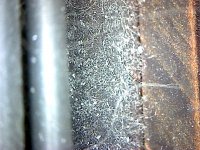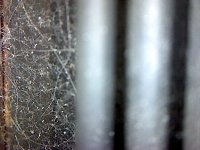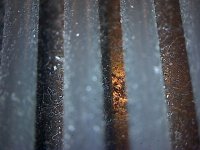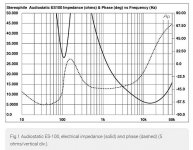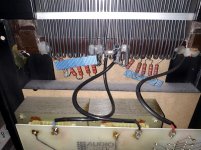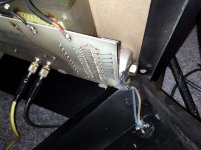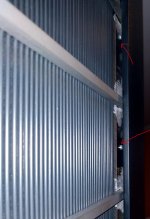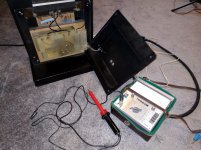Friend o mine bought pair of ES 100.
Unfortunately, they play quietly.
When I increase the volume the music started to sound really bad (distortions).
I check electroncics and it looks OK (I do not measure yet HV section).
Probably (as usuall) there is a problem with diagphram (dirty) and conducting coating. I use USB microscope to inspect diaphragm (see encl photo).
Any idea how to repair it ?
Unfortunately, they play quietly.
When I increase the volume the music started to sound really bad (distortions).
I check electroncics and it looks OK (I do not measure yet HV section).
Probably (as usuall) there is a problem with diagphram (dirty) and conducting coating. I use USB microscope to inspect diaphragm (see encl photo).
Any idea how to repair it ?
Attachments
I would certainly start with a gentle vacuuming. Use a soft brush attachment and see if that's sufficient to get all the muck off the wires and diaphragm. Also make sure the area around the perimeter is clean (where the diaphragm attaches to the frame), around the silicone dots, the bars, etc.
You could also try gently blowing them out with compressed air. Keep the pressure low and aim the stream sideways so it glances off the diaphragm.
With whatever method, go slow and only use as much pressure as is necessary to get them clean. Stretched Mylar is pretty tough, but pierces easily with small diameter objects.
You could also try gently blowing them out with compressed air. Keep the pressure low and aim the stream sideways so it glances off the diaphragm.
With whatever method, go slow and only use as much pressure as is necessary to get them clean. Stretched Mylar is pretty tough, but pierces easily with small diameter objects.
I'm afried it's owners cat's fur.Is that hair all over the diaphragm? Could be a matter of just cleaning them up.
Do you think that cleaning solve problem ?I would certainly start with a gentle vacuuming. Use a soft brush attachment and see if that's sufficient to get all the muck off the wires and diaphragm. Also make sure the area around the perimeter is clean (where the diaphragm attaches to the frame), around the silicone dots, the bars, etc.
You could also try gently blowing them out with compressed air. Keep the pressure low and aim the stream sideways so it glances off the diaphragm.
With whatever method, go slow and only use as much pressure as is necessary to get them clean. Stretched Mylar is pretty tough, but pierces easily with small diameter objects.
I have no experience with any Planars. What about discharge - shall I wait a few days after disconnecting from power before cleaning ?
I'm not familiar with those. I have Acoustat ESLs whhich can be immersed in water with some dish soap. If the glues used are not water soluble it may be possible with yours. I would make inquiries among those who know these speakers. But first of all I would try an air duster and vacuum. If you do immerse them, make sure they are thoroughly rinsed and dried before recharging.
Last edited:
Careful cleaning with vacuum or compressed air is the easiest first step, and it could fix the problem. If there's enough stuff on the diaphragm it may be bleeding off the bias voltage. In most electrostatic speakers, very, very low current is used for the bias so they can't handle much leakage. When the bias voltage is low, output is also low and can sound distorted. Having a bunch of debris in the speaker can also cause various noises.
It's best to wait at least 6 hours after unplugging the speakers to clean them (overnight is sometimes suggested). Letting the static charges dissipate from the speaker will help the dust/hair release more easily from the diaphragm and wires.
It's best to wait at least 6 hours after unplugging the speakers to clean them (overnight is sometimes suggested). Letting the static charges dissipate from the speaker will help the dust/hair release more easily from the diaphragm and wires.
Last edited:
I test loudspeaker with LF generator and distortion start from 6-8 Wats. it's a rather constant vibration (not noises).
Wen I listen music distortion appears when there is a low frequency (bass) "hit".
I will wait until tommorow and try to clean with brush and compressed air.
Wen I listen music distortion appears when there is a low frequency (bass) "hit".
I will wait until tommorow and try to clean with brush and compressed air.
Last edited:
Depending on the frequency your generator was set to, that's not an uncommon result even with a healthy electrostatic speaker. Playing low frequency sine waves with electrostatics can produce distortion and buzzing at relatively low drive levels. The noises they can produce and what stresses them are a little different than a dynamic speaker.
The fundamental diaphragm resonance of an undamped panel like this has a much higher Q and magnitude than people are typically used to. That frequency will produce large diaphragm movement with relatively little input.
The audio step-up transformers in the interface can also have issues when driven at very low frequencies. If your bias voltage is being pulled down by all the dirt/leakage paths, you're likely supplying more power with music to push the volume up, which may be over-driving the interface.
It's hard to say at this point what's what. None of this means there's not something else going on with the speakers, but it's hard to make that determination without correcting the obvious stuff first.
The fundamental diaphragm resonance of an undamped panel like this has a much higher Q and magnitude than people are typically used to. That frequency will produce large diaphragm movement with relatively little input.
The audio step-up transformers in the interface can also have issues when driven at very low frequencies. If your bias voltage is being pulled down by all the dirt/leakage paths, you're likely supplying more power with music to push the volume up, which may be over-driving the interface.
It's hard to say at this point what's what. None of this means there's not something else going on with the speakers, but it's hard to make that determination without correcting the obvious stuff first.
I do not use extremally low frequencies.
Based on impedance chart published here:
Audiostatic ES-100 loudspeaker Measurements | Stereophile.com
I check a few points only (see enclosed results). Of course I determine "distortion point" by my old ears so this is estimated measurement but still 4.9W for 100Hz look's for me a little strange.
Based on impedance chart published here:
Audiostatic ES-100 loudspeaker Measurements | Stereophile.com
I check a few points only (see enclosed results). Of course I determine "distortion point" by my old ears so this is estimated measurement but still 4.9W for 100Hz look's for me a little strange.
Attachments
As a point of reference, the Quad ESL-63 service manual states:
"When applying Steady State input signals to the loudspeaker these should not exceed 10V rms."
from the Resonance Checks section:
"Increase the volume until the voltmeter reads 8V rms. Gradually sweep up and down the frequency range. The loudspeaker response should be pure and free from rattles at all frequencies except at approximately 50 Hz where diaphragm resonance occurs."
These are suggestions from the manufacturer for a properly functioning, clean, highly regarded electrostatic speaker that includes damping of its diaphragm resonance. When dealing with a dirty, undamped speaker, I would expect poorer performance.
"When applying Steady State input signals to the loudspeaker these should not exceed 10V rms."
from the Resonance Checks section:
"Increase the volume until the voltmeter reads 8V rms. Gradually sweep up and down the frequency range. The loudspeaker response should be pure and free from rattles at all frequencies except at approximately 50 Hz where diaphragm resonance occurs."
These are suggestions from the manufacturer for a properly functioning, clean, highly regarded electrostatic speaker that includes damping of its diaphragm resonance. When dealing with a dirty, undamped speaker, I would expect poorer performance.
Last edited:
This information follows Quad impedance chart. Accidentaly I do not exceed 8V RMS and do not try to go bellow 60HZ.As a point of reference, the Quad ESL-63 service manual states:
"When applying Steady State input signals to the loudspeaker these should not exceed 10V rms."
I clean first panel by vacum with brush and now I'm "hunting" for single "hair" (stiil a lot of remain) 🙂.
Is anybody have copy of ES100 manual ? How long I should wait after connecting power to play music ?
Most of the audldiostatics which have never had any repair, probably need yo be refurbished as the conductivity of the mylar may be gone. Some people claim to have saved an audiostatic by cleaning the membrane carefully with small brushes and a detergent like 'glassex'. I wouldnt be surprised that a conductive residu (soap!) Is responsible for the rebirth of the audiostatic and I dont know how long things will keep working.
Dont torture audiostatics with sub 50Hz. The trannies might go into saturation and the poorly damped membrane might misbehave.
Dont torture audiostatics with sub 50Hz. The trannies might go into saturation and the poorly damped membrane might misbehave.
I do not go bellow 80Hz.
After cleainig sound improve for a few minutes and then distortion appear again.
Sometime it's a "crack" on the mid/high sometime "buzz" on the low frequencies.
When sound level is low there is no any problem.
It looks like former owner try to refurbish film (there are screws around internal frame) and instead of oryginal parts somebody put Siemens (looks like from washing machine) 30mikro capacitor and wirewound resistor with alu radiator.
After cleainig sound improve for a few minutes and then distortion appear again.
Sometime it's a "crack" on the mid/high sometime "buzz" on the low frequencies.
When sound level is low there is no any problem.
It looks like former owner try to refurbish film (there are screws around internal frame) and instead of oryginal parts somebody put Siemens (looks like from washing machine) 30mikro capacitor and wirewound resistor with alu radiator.
A few photos of „modified” ES100.
Somebody exchange input capacitor (resistor too), add “audiophile mains cable” and fastened frames by screw.
Film was probably exchanged too but looking for another modifications I’m not sure about quality of service.
Somebody exchange input capacitor (resistor too), add “audiophile mains cable” and fastened frames by screw.
Film was probably exchanged too but looking for another modifications I’m not sure about quality of service.
Attachments
At lower input levels where it is behaving, does the speaker seem to have decent output now, or does the volume seem very low? At 2.83 volts in, most electrostatics will be in the low 80 dB range at 1 meter.
If your output is significantly lower than that, you can try to reach your high voltage probe in to the diaphragm and check to see if that bias voltage is also on the diaphragm in multiple spots. Probe very lightly though, or use a flat piece, very flexible loop, or something, so it's less likely that a hole will get punched in the diaphragm.
If output seems about right at lower input levels, you may want to sweep through the bass range with your signal generator and see at what frequencies the diaphragm resonances occur. If they are very low, the diaphragm may have lost tension, which makes it less stable and more likely to get sucked into the stator. Another way to approach this is to decrease the bias and see if the speaker behaves more normally with more input. You can do this with a variac on a low-frequency, simple multiplier.
If your output is significantly lower than that, you can try to reach your high voltage probe in to the diaphragm and check to see if that bias voltage is also on the diaphragm in multiple spots. Probe very lightly though, or use a flat piece, very flexible loop, or something, so it's less likely that a hole will get punched in the diaphragm.
If output seems about right at lower input levels, you may want to sweep through the bass range with your signal generator and see at what frequencies the diaphragm resonances occur. If they are very low, the diaphragm may have lost tension, which makes it less stable and more likely to get sucked into the stator. Another way to approach this is to decrease the bias and see if the speaker behaves more normally with more input. You can do this with a variac on a low-frequency, simple multiplier.
A basic problem is speaker "loudness". They paly nice but too quiet.
When I increase volume distortion appears. When I use signal generator I do not find any specific frequency when distortion start (see enclosed table).
When I play music distortions appear on low frequencies but sometimes "pops" appears also on "highs".
Thanks’ for suggestion - I'll check HV on diaphragm.
When I increase volume distortion appears. When I use signal generator I do not find any specific frequency when distortion start (see enclosed table).
When I play music distortions appear on low frequencies but sometimes "pops" appears also on "highs".
Thanks’ for suggestion - I'll check HV on diaphragm.
I was trying to cover as many possibilities in one post as I could with limited data. The ideas were not all driving at the same potential problem.
On the distortion issue: if the speakers' output is very low and you are putting a lot of power to them to make up for that, you may be saturating the transformers, which will produce distortion. Another possibility is that your amp isn't happy at high levels with an electrostatic load (more capacitive phase angle than most other speakers combined with very low impedance at high frequency - some amps don't like either of those).
My comment about the frequency generator and resonance was not about distortion. It was about trying to determine whether the diaphragm is slack. If the output is very low but otherwise the speaker seems OK, this is a less likely issue, but I will discuss it briefly anyway. Any undamped electrostatic speaker will have a prominent peak in output caused by the diaphragm's fundamental resonance. This is mostly determined by the diaphragm tension. Diaphragm tension is also necessary to produce a stable speaker. So if the resonance is lower than intended, the speaker is also less stable than intended. Again, this is not as likely since you are saying low output is the major issue.
On the distortion issue: if the speakers' output is very low and you are putting a lot of power to them to make up for that, you may be saturating the transformers, which will produce distortion. Another possibility is that your amp isn't happy at high levels with an electrostatic load (more capacitive phase angle than most other speakers combined with very low impedance at high frequency - some amps don't like either of those).
My comment about the frequency generator and resonance was not about distortion. It was about trying to determine whether the diaphragm is slack. If the output is very low but otherwise the speaker seems OK, this is a less likely issue, but I will discuss it briefly anyway. Any undamped electrostatic speaker will have a prominent peak in output caused by the diaphragm's fundamental resonance. This is mostly determined by the diaphragm tension. Diaphragm tension is also necessary to produce a stable speaker. So if the resonance is lower than intended, the speaker is also less stable than intended. Again, this is not as likely since you are saying low output is the major issue.
- Home
- Loudspeakers
- Planars & Exotics
- Audiostatic ES100 distortion
